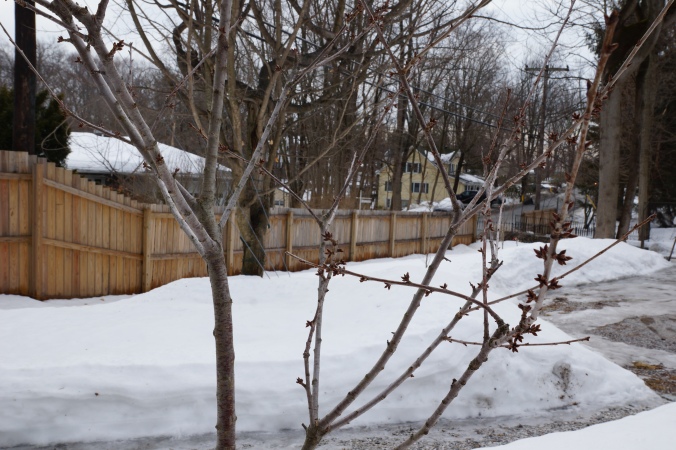
Close up of cherry tree branches. Notice the limb on the right growing left, toward the trunk. Though it’s sad to cut off a branch with nice buds on it, it will benefit the overall health and productivity of the tree.
Pruning is a necessary chore to ensure the health and productivity of your fruit trees. And fruit trees vary as to the age each branch produces fruit, which is important to know before you start cutting. Peach trees fruit on last year’s growth—one-year-old wood—while cherry and pear trees produce fruit on two-to-three year old wood. I had lots of fruit last year for the size of my three-year-old peach trees. However, while my cherries flowered lightly, they only produced three cherries. Three. Individual. Cherries. All on the same tree. Leaving two cherry trees that did not fruit despite blossoms. And my two pear trees did not flower. So what this means is that I am really optimistic about fruit this year because all my trees are of bearing age, but I want to encourage them as best I can, rather than just hoping and waiting.
Fruit trees should be pruned lightly before they break dormancy (before the leaves return). A heavy pruning will result in more new vegetative growth in the spring rather than fruit production, so only prune what is necessary and save the rest for later in the season or the following year. I pruned all my trees a couple days ago as the snow is beginning to melt and our days have been consistently above freezing for about a week.
My first goal was to remove dead or damaged wood, followed by branches that were crossing or growing toward the interior. This resulted in less than four cuts on each tree. My cherry trees are already growing in their desired form, so I don’t think I will need to do any further pruning after they flower to train their shape. However, I will do another prune of my peach trees in late spring to encourage a flush of new growth and fruit production for next year’s crop.
One of my pear had an excessively upright shape, so I thinned a few more narrow vertical branches to allow me to insert branch spreaders in the remaining crotches to train it into a more conical shape with horizontal main limbs. In general, horizontal limbs set fruit, while vertical branches produce more vegetation. And since I have yet to grow a pear, I will be doing everything I can to coax it into fruiting and will post about training my trees in about a week.
However, during this pruning process, I did make one mistake. I have a three-year-old Japanese maple in the center of my driveway. And while I was pruning the fruit trees, I assumed I could do the maple too. I should not have made that assumption, as now is the worst time to prune Japanese maples, due to the sap that has started to run. While pruning now should not damage the tree (as I didn’t tear any bark during my cuts), it can cause the tree to ooze, which can be unsightly and encourage fungal infection. I will have to wait and see. I need to remind myself not to be hasty. After all, gardening is the practice of patience, which isn’t always my greatest trait.


